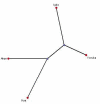Genetic structure in four West African population groups
- PMID: 15978124
- PMCID: PMC1180433
- DOI: 10.1186/1471-2156-6-38
Genetic structure in four West African population groups
Abstract
Background: Africa contains the most genetically divergent group of continental populations and several studies have reported that African populations show a high degree of population stratification. In this regard, it is important to investigate the potential for population genetic structure or stratification in genetic epidemiology studies involving multiple African populations. The presences of genetic sub-structure, if not properly accounted for, have been reported to lead to spurious association between a putative risk allele and a disease. Within the context of the Africa America Diabetes Mellitus (AADM) Study (a genetic epidemiologic study of type 2 diabetes mellitus in West Africa), we have investigated population structure or stratification in four ethnic groups in two countries (Akan and Gaa-Adangbe from Ghana, Yoruba and Igbo from Nigeria) using data from 372 autosomal microsatellite loci typed in 493 unrelated persons (986 chromosomes).
Results: There was no significant population genetic structure in the overall sample. The smallest probability is associated with an inferred cluster of 1 and little of the posterior probability is associated with a higher number of inferred clusters. The distribution of members of the sample to inferred clusters is consistent with this finding; roughly the same proportion of individuals from each group is assigned to each cluster with little variation between the ethnic groups. Analysis of molecular variance (AMOVA) showed that the between-population component of genetic variance is less than 0.1% in contrast to 99.91% for the within population component. Pair-wise genetic distances between the four ethnic groups were also very similar. Nonetheless, the small between-population genetic variance was sufficient to distinguish the two Ghanaian groups from the two Nigerian groups.
Conclusion: There was little evidence for significant population substructure in the four major West African ethnic groups represented in the AADM study sample. Ethnicity apparently did not introduce differential allele frequencies that may affect analysis and interpretation of linkage and association studies. These findings, although not entirely surprising given the geographical proximity of these groups, provide important insights into the genetic relationships between the ethnic groups studied and confirm previous results that showed close genetic relationship between most studied West African groups.
Figures



Similar articles
-
A genome-wide search for type 2 diabetes susceptibility genes in West Africans: the Africa America Diabetes Mellitus (AADM) Study.Diabetes. 2004 Mar;53(3):838-41. doi: 10.2337/diabetes.53.3.838. Diabetes. 2004. PMID: 14988271
-
Influence of language and ancestry on genetic structure of contiguous populations: a microsatellite based study on populations of Orissa.BMC Genet. 2005 Feb 5;6:4. doi: 10.1186/1471-2156-6-4. BMC Genet. 2005. PMID: 15694006 Free PMC article.
-
Genetic characterization of Guinea-Bissau using a 12 X-chromosomal STR system: Inferences from a multiethnic population.Forensic Sci Int Genet. 2017 Nov;31:89-94. doi: 10.1016/j.fsigen.2017.08.016. Epub 2017 Aug 24. Forensic Sci Int Genet. 2017. PMID: 28858674
-
Substructure of a Tunisian Berber population as inferred from 15 autosomal short tandem repeat loci.Hum Biol. 2008 Aug;80(4):435-48. doi: 10.3378/1534-6617-80.4.435. Hum Biol. 2008. PMID: 19317598
-
Morphological and genetic variation in Tilapia guineensis in West African coastal waters: A mini review.Biotechnol Rep (Amst). 2019 Jul 19;24:e00362. doi: 10.1016/j.btre.2019.e00362. eCollection 2019 Dec. Biotechnol Rep (Amst). 2019. PMID: 31413949 Free PMC article. Review.
Cited by
-
Stroke genomics in people of African ancestry: charting new paths.Cardiovasc J Afr. 2015 Mar-Apr;26(2 Suppl 1):S39-49. doi: 10.5830/CVJA-2015-039. Cardiovasc J Afr. 2015. PMID: 25962947 Free PMC article. Review.
-
Recruitment of Yoruba families from Nigeria for genetic research: experience from a multisite keloid study.BMC Med Ethics. 2014 Sep 2;15:65. doi: 10.1186/1472-6939-15-65. BMC Med Ethics. 2014. PMID: 25182071 Free PMC article.
-
Male-female differences in the genetic regulation of t-PA and PAI-1 levels in a Ghanaian population.Hum Genet. 2008 Dec;124(5):479-88. doi: 10.1007/s00439-008-0573-x. Epub 2008 Oct 25. Hum Genet. 2008. PMID: 18953568 Free PMC article.
-
A genomewide comparison of population structure at STRPs and nearby SNPs in humans.Mol Biol Evol. 2009 Jun;26(6):1369-77. doi: 10.1093/molbev/msp052. Epub 2009 Mar 16. Mol Biol Evol. 2009. PMID: 19289600 Free PMC article.
-
A likelihood ratio test of population Hardy-Weinberg equilibrium for case-control studies.Genet Epidemiol. 2009 Apr;33(3):275-80. doi: 10.1002/gepi.20381. Genet Epidemiol. 2009. PMID: 19025784 Free PMC article.
References
-
- Tishkoff SA, Williams SM. Genetic analysis of African populations: Human evolution and complex disease. Nat Rev Genet. 2002;3:611–621. - PubMed
Publication types
MeSH terms
LinkOut - more resources
Full Text Sources
Miscellaneous

